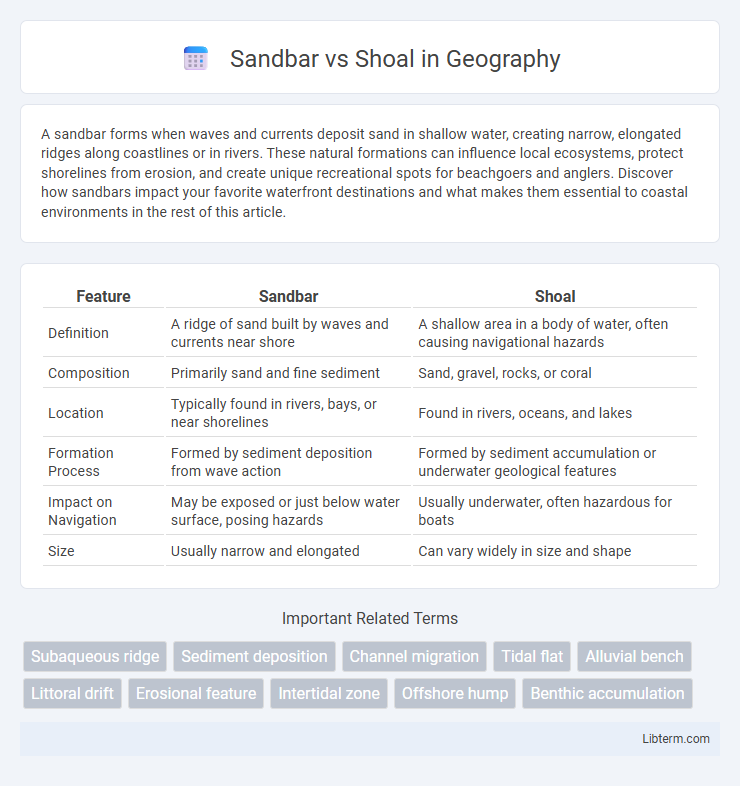A sandbar forms when waves and currents deposit sand in shallow water, creating narrow, elongated ridges along coastlines or in rivers. These natural formations can influence local ecosystems, protect shorelines from erosion, and create unique recreational spots for beachgoers and anglers. Discover how sandbars impact your favorite waterfront destinations and what makes them essential to coastal environments in the rest of this article.
Table of Comparison
| Feature | Sandbar | Shoal |
|---|---|---|
| Definition | A ridge of sand built by waves and currents near shore | A shallow area in a body of water, often causing navigational hazards |
| Composition | Primarily sand and fine sediment | Sand, gravel, rocks, or coral |
| Location | Typically found in rivers, bays, or near shorelines | Found in rivers, oceans, and lakes |
| Formation Process | Formed by sediment deposition from wave action | Formed by sediment accumulation or underwater geological features |
| Impact on Navigation | May be exposed or just below water surface, posing hazards | Usually underwater, often hazardous for boats |
| Size | Usually narrow and elongated | Can vary widely in size and shape |
Definition of Sandbar
A sandbar is a natural landform composed primarily of sand, formed by the accumulation of sediment deposited by currents, waves, and tides along coastlines or in rivers. Unlike shoals, which can consist of various materials like rock or gravel and often pose navigation hazards by being shallow areas, sandbars are typically recognized for their sandy composition and dynamic shifts in shape and size. Sandbars serve important ecological functions by providing habitats for wildlife and protecting shorelines from erosion.
Definition of Shoal
A shoal is a naturally occurring shallow area in a body of water formed by the accumulation of sand, gravel, or sediment, often posing navigational hazards due to reduced water depth. Unlike sandbars, which are typically elongated ridges of sand exposed at low tide, shoals can be broader and may remain submerged or partially submerged. Understanding the definition of shoal is crucial for maritime navigation and coastal management to prevent accidents and ensure safe passage.
Formation Processes: Sandbar vs Shoal
Sandbars form primarily through the deposition of sand by wave action and longshore currents along coastlines, often creating elongated ridges parallel to the shore. Shoals develop from the accumulation of sediment, including sand, silt, and shell fragments, due to tidal currents and river outflows in shallow waters, sometimes extending underwater and affecting navigation. Both features result from sediment transport and deposition but differ in their typical locations and sediment composition.
Physical Characteristics Comparison
A sandbar is a narrow, elongated ridge of sand formed by wave and current action, typically appearing parallel to the shore and often exposed during low tide. A shoal, on the other hand, refers to a submerged or partially submerged elevation of sand, gravel, or other sediment that makes the water shallower and can extend over a wider, less defined area than a sandbar. Both sandbars and shoals influence coastal dynamics but differ in shape, size, and exposure frequency.
Common Locations Worldwide
Sandbars commonly form along coastlines, river mouths, and estuaries where sediment accumulates due to wave and current action, with notable examples including the Outer Banks in North Carolina and the Sundarbans in India and Bangladesh. Shoals are frequently found in shallow coastal waters, near coral reefs, and in riverbeds, such as the shoals of the Thames River in England and Mobile Bay in Alabama. Both features significantly influence navigation and local ecosystems in these prominent global locations.
Ecological Importance of Sandbars and Shoals
Sandbars and shoals provide critical habitats for diverse aquatic species, supporting spawning grounds and shelter for fish and invertebrates essential to marine ecosystems. These formations contribute to nutrient cycling by trapping organic materials and promoting sediment deposition, which enhances coastal stability and water clarity. The ecological role of sandbars and shoals extends to protecting shorelines from erosion by dissipating wave energy and maintaining the balance of estuarine and nearshore environments.
Hazards to Navigation
Sandbars and shoals present significant hazards to navigation due to their shallow depths and shifting sediments. Sandbars, often formed by wave and current action, can rise abruptly and cause vessels to run aground unexpectedly. Shoals, which are naturally occurring underwater ridges or banks, reduce water depth and complicate safe passage, increasing the risk of vessel grounding or collision.
Human Interaction and Activities
Sandbars often serve as popular sites for recreational activities such as swimming, sunbathing, and fishing due to their exposed, shallow areas easily accessible from the shore. Shoals, while similar, tend to be more submerged and can pose navigational hazards, making them critical considerations for boating and marine traffic management. Both features influence local ecosystems and tourism, with sandbars providing safe habitats for birds and fish, attracting eco-tourism and educational activities.
Changes Over Time: Dynamic vs Stable
Sandbars exhibit dynamic changes over time due to constant sediment deposition and erosion influenced by tides and currents, resulting in shifting shapes and locations. Shoals tend to remain more stable, formed by longer-term sediment accumulation that creates relatively fixed underwater ridges or banks. The dynamic nature of sandbars makes them more transient, while shoals provide enduring underwater features important for navigation and marine habitats.
Summary Table: Sandbar vs Shoal Differences
A sandbar is a submerged or partially exposed ridge of sand formed by wave and current action, typically found parallel to a shoreline, whereas a shoal is a naturally occurring shallow area in a body of water that can consist of sand, gravel, or other sediments. Sandbars are often temporary and shift with tides and currents, while shoals tend to be more stable and can pose navigational hazards. Key differences include formation, composition, stability, and their impact on marine navigation and coastal environments.
Sandbar Infographic

 libterm.com
libterm.com